Eduard 1/48 Fw-190A-3 Profipack
RAF pilots first reported encountering a new German radial-engine fighter on cross-Channel missions in August 1941, with increasing numbers in September, though their main opponents were still Bf-109Fs. Their reports of its incredible flying abilities were met with official disbelief on the part of RAF intelligence (which did in fact know about the airplane), and pilots were initially told they must have run across ex-French Hawk-75s being used by the Germans because they were “scraping the bottom of the barrel.” In his book “Wing Leader,” Johnny Johnson relates that the intelligence officer was run out of the room by the pilots who had just survived an encounter with these “Hawk 75s” when that announcement was made, as the pilots exclaimed that no pre-war fighter could perform like the airplane they had just fought. RAF HQ finally admitted that the airplane was the new Focke-Wulf Fw-190.
These first Fw-190s that arrived were Fw-190A-1 sub-types; they initially equipped II Gruppe of JagdGeschwader 26, one of two Geschwadern facing the RAF on the Channel Front in northern France. The first aircraft arrived on July 1, 1941, and the Gruppe was completely equipped by September 1. The Gruppenkommandeur, Hauptmann Walter Adolph, was the first pilot lost, during combat with Spitfires on September 18. The armament of four MG 17 7.62mm machine guns in the fuselage and wing root, and two MG-FF cannon outboard of the landing gear, was really not optimal, with the slow-firing MG-FF being completely unsatisfactory for aerial combat. During October 1941, III Gruppe began a slow conversion to the new fighter, which allowed them to take in the Fw-190A-2s that began arriving in December. Trouble with the BMW 801C engine - which had originally been severe enough that the entire Fw-190 program was in jeopardy - kept serviceability rates low throughout the end of 1941.
In February 1942, the RAF finally came up against large numbers of the Focke-Wulf during the “Channel Dash,” when the defending Germans decimated the British attackers, in no small part due to the fact that III JG 26 was now partially equipped with Fw-190A-2s, which replaced the inboard machine gun with the excellent MG 151 20mm cannon. In March 1942, more of these phenomenal airplanes were encountered as JagdGeschwader 2 re-equipped with the airplane. These fighters appeared to have even better performance than those the RAF had first run across the previous fall, which was due to the A-3 being powered by the BMW 801D-2.
By April, 1942, all of the German units opposing the RAF on the Channel coast - including JG1 in the Netherlands - were completely equipped with the new fighter, and their ascendancy over their RAF opponents was comparable to that of the Albatros D.III during “Bloody April” of 1917; in fact April 1942 saw some of the highest RAF losses of the entire war, with no fewer than 103 Spitfires shot down by the Fw-190s. It was clear the fighter was superior to the Spitfire on all counts other than its turning capability, to which Wing Commander Al Deere commented, “turning doesn't win battles!”
After a battle on June 1, 1942, that saw 10 Spitfires of the Debden Wing, including the Wing Commander, shot down by JG 26, with another 10 Spitfires badly damaged - for what turned out to be no losses on the part of the Germans despite RAF claims of three shot down - the RAF was desperate to get hold of one of these airplanes and discover its secrets. Plans were mounted for a commando raid on a German air base, with the goal of putting a top British test pilot in the cockpit, and stealing a Fw-190 to fly it back to England.
On June 23, 1942, the RAF got lucky when Leutnant Arnim Faber, Gruppe Adjutant of III/JG 2 became disoriented in a battle over the Channel and mistook Cornwall for Brittany, landing in his brand-new Fw-190A-3 at RAF Pembrey.
The first thing RAF tests revealed was that this airplane had its engine derated by 200 horsepower to extend the life of the engine! This was at a time when the RAF was souping up Merlin 45s in Spitfire Vs to the point where they were making complete engine changes every 50 hours after burning up the engine, in an attempt to keep up with the Focke-Wulf. Adding insult to injury, tests demonstrated that the Fw-190 outperformed the Spitfire V on all points but turning circle below 25,000 feet, and that a Focke-Wulf pilot could break off combat at will with any Spitfire V. Aerobatics at all speeds were crisp, with the fastest aileron roll of any fighter in the war, while controls remaining remarkably light in a steep dive. Even the new Spitfire IX - brought into service specifically to oppose the German fighter - was only marginally faster than the Fw-190, and only at certain altitudes, with the Spitfire IX only coming into its own above 25,000 feet. In maneuverability, the Fw-190 was superior, and could get away from the British rival with a dive at any point in a fight. All the RAF pilots who flew it were amazed at its ability to flick roll equally well to left or right.
The first Allied fighter that was fully capable of taking on the Fw-190 was the Merlin-powered P-51B Mustang, and even then the superiority was only marginal. It was only with the deterioration in the quality of flying personnel that the Wurger was finally overcome.
Among the experten mounted on the Fw-190A-3 in the spring of 1942 was Hauptmann Joachim Müncheberg, Gruppen Kommandeur of II/JG 26 based at Abbeville-Drucat. Müncheberg had gained a measure of fame as Staffelkapitän of 7.III/JG 26 in the Mediterranean in the spring and summer of 1941, during which he increased his scoreby 43 while changing the air war over Malta in February and March, then fighting over the Balkans and North Africa before returning to France in September, having suffered no losses among his pilots. Of his 102 aerial victories achieved over the Western Allies, 46 were against Spitfires. He received the Knight's Cross of the Iron Cross with Oak Leaves and Italian Medaglia d'oro al Valore Militare. Upon his return from the Mediterranean, he was promoted to command II/JG 26, a position he held until October 1942 when he returned to North Africa as Kommodore of JG 77 to oppose the RAF in the aftermath of the Battle of El Alamein. He was shot down and killed on March 23, 1943 over Tunisia by Captain Theodore Sweetman of the USAAF 52nd Fighter Group after scoring his 135th victory.
Eduard began releasing a completely new series of radial engine Fw-190s earlier this year. With the release of this kit, they have now released the Fw-190A-3, A-4, A-5, and A-8/R8. With the parts in the kit, a modeler can do any radial engine Wurger.
These are the best kits of the Fw-190 available in any scale. Interestingly, rather than design them in a modular style as a certain other major manufacturer does, each sub-type is molded with all the specific relevant details as a separate run; this vastly improves “buildability.” Surface detail is petite and overall fit is perfect (so long as you realize it is so precise you must be careful to remove all sprue nubs on the parts and keep paint off surfaces to be glued). The Profipack kits include photo-etch cockpit detail and an interesting selection of markings possibilities on decals by Cartograf.
Construction is simple: read and follow the instructions to do the particular sub-variant you have chosen, take care in cleaning off all sprue nubs when you cut the parts off the sprues, take your time in careful assembly, and in a matter of a few hours you will have a really nice model, lacking (mostly) any filler on any join (any filler used is due to “modeler-induced mistakes”), ready for painting.
One particular thing to do is to lightly scrape around the inner gun bay door that sticks out from the upper wing part, and to lightly scrape the area of the fuselage part where that will fit. If you don't do that, you will be forced to engage in some industrial-strength pushing and shoving to get the parts together. If you do this, the parts will “click together.”
Eduard's painting instructions for this airplane call out a camouflage of RLM 74/75/76. However, its serial number, 257, is low and close to that of the Fw-190 Arnim Faber delivered to the RAF, which was described at the time as being painted “turquoise lower surfaces, grey-green and dark olive green uppers,” a very good description of RLM 71/02/65. The first runs of Wurgers up through the early Fw-190A-3s at the two factories they were being built at are known to have used this camouflage scheme. Exactly when the changeover was accomplished is unclear, but it is likely that Werkenummer 257 was one of them.
I chose to do this scheme because of its visual difference from the “standard scheme.” I used Tamiya XF-61 Dark Green and XF-22 “RLM Grey,” which I lightened about 20% with white to get the color closer to what it should be (in fact, RLM02 is one of those colors that is not “exact” and varied from manufacturer to manufacturer, but Tamiya's color is a bit dark straight out of the bottle, particularly used on 1/14 or 1/72 scale models). I used my last bottle of Gunze-Sangyo RLM65 Hellblau for the lower surfaces.
The kit decals are excellent and went down without problem under a coat of Micro-Sol.
I assembled and mounted the landing gear; Eduard's design is such that it is close to impossible to not get the gear installed at the correct angles, which is frequently the downfall of many otherwise-great Wurger models. Just to be sure, when you look straight down on the model after attaching the gear but before installing the wheels, the axle of the main gear should be fully visible just ahead of the wing leading edge.
I used the “open” option for the canopy. Eduard supplies “open” and “closed” canopies since the FW-190 canopy narrowed as it was slid back on its rails.
The Fw-190s of this period were extremely clean, other than the heavy exhaust associated with the BMW801D engine. I used Tamiya “smoke” to create exhaust stains.
Did I mention how much I love the new Eduard Wurgers? Their Merlin-60 series Spitfires are the best out there, and their Bf-109s are at the top of anyone's list. To me, the Fw-190 exceeds both of these, which is a high bar indeed to clear. Highly recommended to any Luftwaffe fan who has done a few models. An advanced beginner, if they take their time and work carefully, can get a great model. It's guaranteed success for those with more experience. The original airplane was considered an “ace-maker” and this kit follows that tradition.
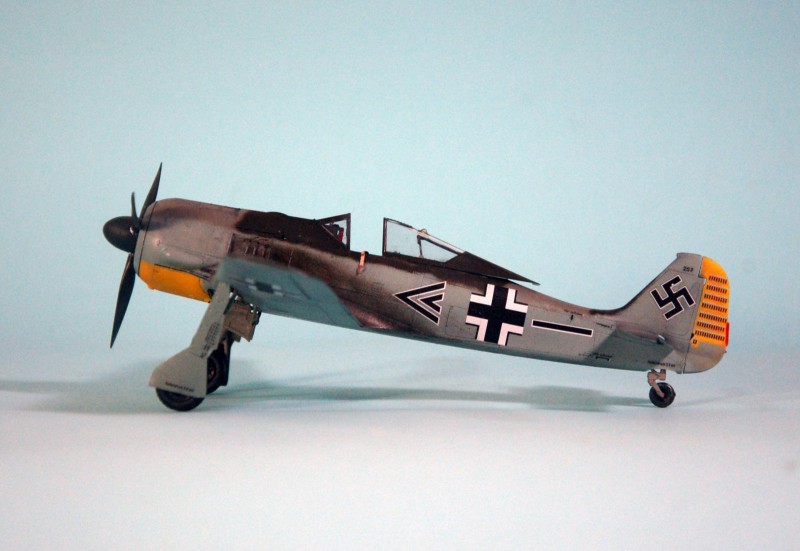
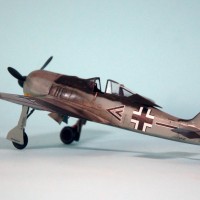

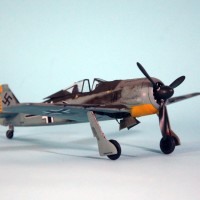
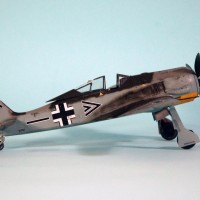
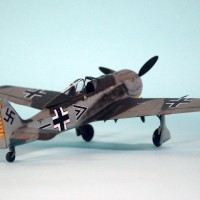
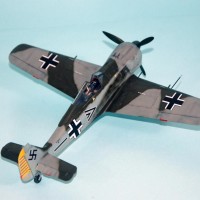
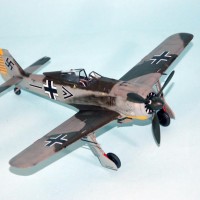
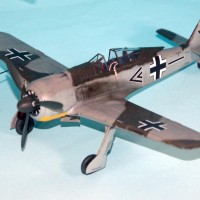

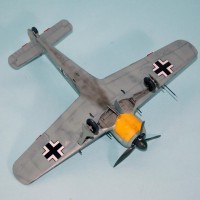
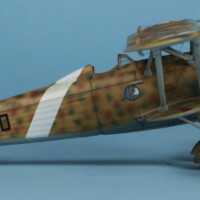

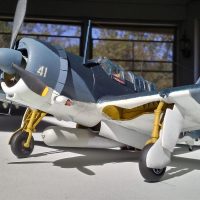

Me ha gustado la historia y la maqueta.
Seems like a good model and you did it justice.
Does anyone know what happened to the FW 190 that landed at the wrong airstrip and were evaluated by the British?
Armin Faber’s A-3? After extensive trials and exams it was struck off charge and scrapped late 1943
Tom, I have to agree with you, this kit is perhaps the best of the recent string of WW2 fighters Eduard put on the market, if only by a hair’s width. I’m still to purchase an overtree for an early A (not sure if the A-2 or 3) but it’s bound to be as good as the A-5 I built and presented here some time ago.
Müncheberg 190 is a classic build and yours does full justice to it. Thumbs up
They have the A-3 in overtrees now. Those are a great bargain. I got the A-4 overtrees earlier this year. So long as you have some seatbelts, you can't see much else in a 190 cockpit anyway. The one thing I really like is how they do the kit without "inserts." I have the new A-8/R2 Sturmbock, and they molded the armor around the cockpit, it looks just beautiful.
Great build Tom, I enjoyed the History lesson as well. Super.
Looks great Tom! Another beauty.
Great model, Tom. Your accompanying narratives are always great, and really add to your posts. Thank you and Merry Christmas.
You too!
beautifully done...love those radials
Great job once again, Tom...both on the build and on the narrative. The Fw 190 is a perfect example of form and function going hand in hand. OBTW, this kit continues my addiction to Eduard plastic.
Between Eduard and Airfix, I'm set for life.
One of the neat things about YouTube and the hobby is that folks are producing shorts of shows. Walking the aisle with a camera and spreading the good word. Lots of Eduard and Airfix on the tables ...or modeling therapy for those of us chasing the grind of making a buck. I am seeing a lot of European shows and now tutorials on how to build and paint these kits. But, the one thing missing ...is good writing.